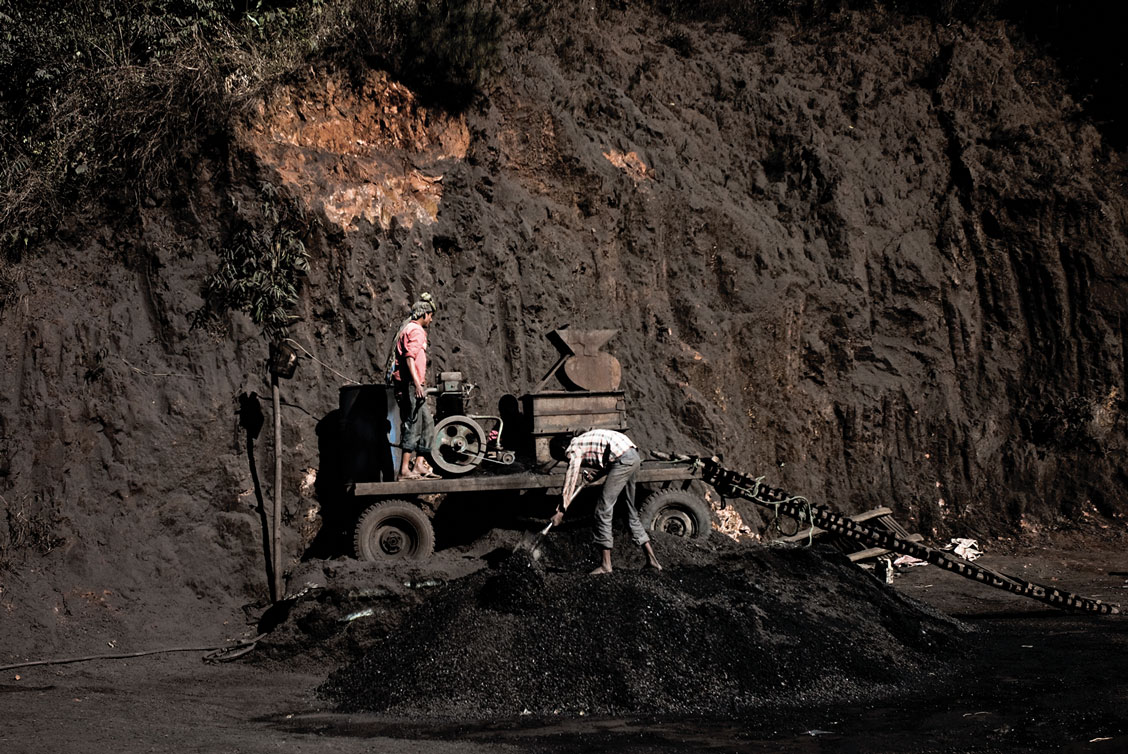by RICHARD MARTIN
 Miners extract coal at one of the many mines in the Khasi Hills in Meghalaya
Miners extract coal at one of the many mines in the Khasi Hills in Meghalaya
Can India modernize its manufacturing economy and supply electricity to its growing population without relying heavily on coal—and quite possibly destroying the global climate?
An old man wakes on the floor of a hut in a village in southern India. He is wrapped in a thin cotton blanket. Beside him, music wails softly on a transistor radio. A small wood fire smolders on the floor, filling the space with a light haze; above it,the bamboo timbers of the hut’s roof are charred to a glossy black.
The man’s name is Mallaiah Tokala, and he is the headman of Appapur village, in the Amrabad Tiger Reserve in Telangana state. On his forehead he wears the vibhuti, the sacred daub of white ash. He is uncertain of his exact age, but he is well into his 10th decade. He has lived in this village his whole life, a period that encompasses the tumultuous 20th-century history of India: the rise of Gandhi, the Salt March, the end of the Raj and the coming of independence, Partition and the bloodshed that followed, the assassination of Rajiv Gandhi and the dawning of a new era of sectarian violence and terrorism. And now he has lived long enough to witness the coming of electricity to Appapur, in the form of solar-powered lights and TVs and radios.
On the wall of the hut a single LED lightbulb glows softly, connected through the roof to a black cable that stretches to a 100-watt solar panel on the roof of a concrete house nearby. It is a direct outcome of the policies of the central government, a thousand miles to the north in Delhi. Appapur is a “solar village,” one of the showcases for the government’s drive to bring solar power to small, unelectrified villages across India.
It’s a huge task. At least 300 million of India’s 1.25 billion people live without electricity, as the villagers of Appapur did until a year ago. Another quarter-billion or so get only spotty power from India’s decrepit grid, finding it available for as little as three or four hours a day. The lack of power affects rural and urban areas alike, limiting efforts to advance both living standards and the country’s manufacturing sector.
Since he took power in May 2014, Prime Minister Narendra Modi has made universal access to electricity a key part of his administration’s ambitions. At the same time, he has pledged to help lead international efforts to limit climate change. Among other plans, he has promised to increase India’s renewable-energy capacity to 175 gigawatts, including 100 gigawatts of solar, by 2022. (That’s about the total power generation capacity of Germany.) And therein lies India’s energy dilemma.
Already the world’s third-largest emitter of carbon dioxide and other greenhouse gases, India is attempting to do something no nation has ever done: build a modern industrialized economy, and bring light and power to its entire population, without dramatically increasing carbon emissions. Simply to keep up with rising demand for electricity, it must add around 15 gigawatts each year over the next 30 years. The country gets most of its electricity from aging, dirty coal-fired plants. (It has little domestic production of oil or natural gas.) And its energy infrastructure is in dismal shape. The obsolescence of its power grid was demonstrated by a massive 2012 outage that left more than 600 million people in the dark and drew attention to a utility sector in disarray, with an estimated $70 billion of accumulated debt.
MIT Technology Review for more
